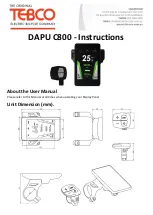
1
Tandem disassembly
Required tools
•
4, 5 and 8 or 10 mm Allen wrench
•
Pin-spanner tool to tighten the chain if necessary (e.g. Park-Tool SPA-1)
•
S&S coupling wrench (no longer needed with the new Z-couplings)
Disassembly
1.
If the tandem is equipped with extras such as racks, lowriders, mudguards or bottle mounts on the stoker lateral tube,
these are removed first.
2.
The first step is to disconnect the shift cables and the rear brake cable at the cable
couplers under the bottom tube. To remove the tension from the cables, it is
recommended to switch gears to the smallest sprocket at the front and rear.
3.
Then remove the barrel adjuster on the down tube (unscrew them on older models)
to adjust the cable. separate the cables from the frame. If the tandem is equipped
with an electric shifting system, only the plugs on the head tube, respectively at the
display and on the captain and stoker bottom brackets are disconnected.
4.
Now the captain handlebar is separated from the frame.
a)
To do so, first unhook the front brake (V-brake) and unscrew the brake caliper, still attached to the brake cable,
with a 5 mm Allen wrench. Then screw the screw back into the thread to avoid losing it. Alternatively, the brake
cable can also be loosened from the brake caliper by unscrewing the 5 mm Allen screw (Note: When
reassembling, the brake may need to be adjusted again). For a caliper brake, the brake caliper is loosened and
the sleeve nut (5 mm Allen) on the back side of the fork crown is unscrewed in succession the entire brake caliper.
b)
To remove the handlebars, first loosen the stem bolts (4 or 5) on the side of the steerer tube and then remove the
headset cap by unscrewing the center 5 Allen screw.
c)
Afterwards, screw the cap of the headset back into the steerer tube to avoid losing it.
d)
The handlebar bolts (4/5) on the disassembled handlebar can be loosened so that it can later be placed flat
and space-saving in the case.
5.
Now the tandem is flipped over so that it stands on the saddles, while the handlebar of the stoker keeps the tandem
from tipping over sideways.
6.
Next, remove the front wheel and the rear wheel by loosening the quick release/ thru axles. Remove the quick release
from the wheel hubs, as these will be packed separately later.
7.
Loosen the cranks of the timing chain with an 8- or 10-mm Allen wrench. The chain and the belt are removed at once.
Tip: with the belt drive, the position of the cranks on the belt and the belt blades can be marked with a colored
marker pen. This makes it easier to find the synchronized crank position when assembling.
8.
Then remove the cranks on the other side.
9.
The chain can be left on the frame. However, the chain stay should be protected from paint scratches with a
protective pad and the chain should be fixed with 2-3 more Velcro pads. If a carrier is packed, the rear derailleur
must be removed from the frame. If knowledge with chain locks are available, SRAM, KMC or Shimano 11-speed
chains can also be disassembled.
























